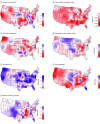Social and Environmental Determinants of Health and Cardio-Kidney-Metabolic Syndrome-Related Mortality
- PMID: 39325449
- PMCID: PMC11427959
- DOI: 10.1001/jamanetworkopen.2024.35783
Social and Environmental Determinants of Health and Cardio-Kidney-Metabolic Syndrome-Related Mortality
Abstract
Importance: It is not well understood if and how various social and environmental determinants of health (SEDoH) are associated with mortality rates related to cardio-kidney-metabolic syndrome (CKM) across the US.
Objective: To study the magnitude of the association strength of SEDoH with CKM-related mortality at the county level across the US.
Design, setting, and participants: This cross-sectional, retrospective, population-based study used aggregate county-level data from the US Centers for Disease Control and Prevention Wide-Ranging Online Data for Epidemiologic Research (WONDER) data portal from 2010-2019. Data analysis occurred from September 2023 to January 2024.
Exposures: A total of 7 diverse SEDoH were chosen, including median annual household income, percentage of racial and ethnic minority residents per county, fine particulate air pollution (PM2.5) concentrations, high-school completion rate, primary health care access, food insecurity, and rurality rate.
Main outcomes and measures: The primary outcome was county-level age-adjusted mortality rate (aaMR) attributable to CKM. The association of county-level CKM-related aaMR with the 7 SEDoH was analyzed using geographically weighted models and the model median coefficients for each covariate studied.
Results: Data from 3101 of 3243 counties (95.6%) were analyzed. There was substantial variation in SEDoH between states and counties. The overall pooled median (IQR) aaMR (2010-2019) in the US was 505.5 (441.3-578.9) per 100 000 residents. Most counties in the lower half of the US had rates much higher than the pooled median (eg, Southern US median [IQR] aaMR, 537.3 [466.0-615.9] per 100 000 residents). CKM-related mortality was positively associated with the food insecurity rate (median [IQR] β = 6.78 [2.78-11.56]) and PM2.5 concentrations (median [IQR] β = 5.52 [-11.06 to 19.70]), while it was negatively associated with median annual household income (median [IQR] β = -0.002 [-0.003 to -0.001]), rurality (median [IQR] β = -0.32 [-0.67 to 0.02]), high school completion rate (median [IQR] β = -1.89 [-4.54 to 0.10]), racial and ethnic minority rate (median [IQR] β = -0.66 [-1.85 to 0.89]), and primary health care access rate (median [IQR] β = -0.18 [-0.35 to 0.07]).
Conclusions and relevance: In this cross-sectional study of county-level data across the US, there were substantial geographical differences in the magnitude of the association of SEDoH with CKM-related aaMR. These findings may provide guidance for deciding local health care policy.
Conflict of interest statement
Figures



References
-
- The Center for Diseases Control and Prevention . CDC WONDER. Updated August 21, 2024. Accessed August 21, 2024. https://wonder.cdc.gov/
-
- Baumer Y, Singh K, Baez AS, et al. Social determinants modulate NK cell activity via obesity, LDL, and DUSP1 signaling. bioRxiv Preprint posted online September 15, 2023. doi: 10.1101/2023.09.12.556825 - DOI
Publication types
MeSH terms
Grants and funding
LinkOut - more resources
Full Text Sources
Medical
Miscellaneous

